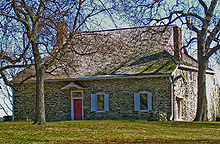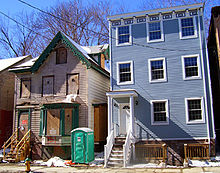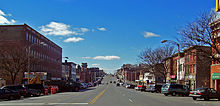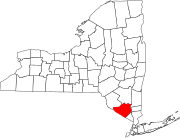History
Exploration and settlement
At the time of European contact the area of Newburgh was occupied by the Waoranek, a branch of the Lenape. The area that became Newburgh was first explored by Europeans when Henry Hudson stopped by during his 1609 expedition up the river that now bears his name. His navigator, Robert Juet, is told to have called the site "a pleasant place to build a town",[3] although some later historians believe he may actually have been referring to the area where Cornwall-on-Hudson now stands.
Around 1683 provincial governor Thomas Dongan purchased the land from the Woaranek. The first settlement was made in the spring of 1709 by fifty-four Palatine refugees, sponsored by Queen Anne of Great Britain. The settlers named it the Palatine Parish by Quassic. In 1743 a ferry had been established between Newburgh and Fishkill Landing.[4] In 1752 the land had been surveyed by Cadwallader Colden and named "Newburgh" after Newborough in his native Scotland.[3]
The American Revolution
Newburgh was the headquarters of the Continental Army from March, 1782 until the latter part of 1783.[3] While the army was camped at Newburgh, some of its senior officers began the "Newburgh conspiracy" to overthrow the government. General George Washington was able to persuade his officers to stay loyal to him. The army was disbanded here in 1783. Washington received the famous Newburgh letter from Lewis Nicola proposing that he become king here. It drew a vigorous rebuke from Washington. In honor of his refusal of that suggestion, Kings Highway, the north-south street on which the Newburgh headquarters is located, was renamed Liberty Street.[5]
Growth in the 19th century
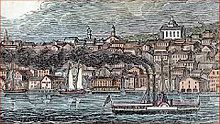
The year 1793 saw Newburgh's first newspaper, The Newburgh Packet. Newburgh was incorporated as a village in 1800 and chartered as a city in 1865. At the time of its settlement it was in Ulster County and was that county's seat. When Rockland County was split from Orange County in 1798, Newburgh and the other towns north of Moodna Creek were put in a redrawn Orange County. Newburgh thus lost its status as the county seat to Goshen. The former Ulster County courthouse still stands as Newburgh's old city courthouse building (currently used as municipal office space).
Newburgh became quite prosperous during the Gilded Age that followed. Newburgh had telephone service in 1879.[4] In 1883 there was a steamboat landing on Second Street. The United States Hotel was on Front Street opposite the landing. Also on Front Street near the landing was the Union Depot.[6] In 1883, the West Shore Railroad inaugurated service to the Pennsylvania Railroad Depot at Jersey City[7] and by 1886 was traveling to Weehawken Terminal, where passengers transferred to ferries to Manhattan.[8]
With its situation on the Hudson River, midway between New York City and Albany, it became a transportation hub and an industrial center. Its industries included manufacturings of cottons, woolens, silks, paper, felt hats, baking powder, soap, paper boxes, brick, plush goods, steam boilers, tools, automobiles, coin silver, bleach, candles, waterway gates, ice machines, pumps, moving-picture screens, overalls, perfumes, furniture, carpets, carburetors, spiral springs, spiral pipe, shirt waists, shirts, felt goods, lawn mowers; shipyards; foundries and machine shops; tanneries; leatherette works; plaster works.
J. J. Nutt made this comment about Newburgh: "The year 1891 finds us the most thriving city on the Hudson, with citizens full of spirit of public enterprise, with public institutions comparatively unequalled, and with apparently every factor and requisite to ensure its bright future as a manufacturing and commercial city of importance. . .".[9]
The development of modern Newburgh

Newburgh was home to the second Edison power plant, installed to power 126 lamps at the Orange Woolen Mill, and was the second American city (after New York's Pearl Street) to have a street lighted using electricity.[4] Broadway, which at 132 feet (40 m) in width is one of the widest streets in the state of New York, runs through the city culminating with views of the majestic Hudson River.
Newburgh played a pivotal role in television history. In October, 1939, RCA chose to test-market televisions in Newburgh, which was within range of the television signal of RCA's experimental station W2XBS. 600 sets were sold in Newburgh at a deep discount. The test-marketing campaign's success encouraged RCA to go forward with developing the new medium. Additionally, with consumer television production ceasing during World War II, those Newburgh households which purchased televisions during 1939 and 1940 were among the few to enjoy television (albeit with a greatly reduced programming schedule) during the war.[10]
Newburgh was one of the first cities in the country to fluoridate its water in 1945.[11]
The 20th century

Newburgh was hit hard economically by several factors in late 20th century and the subsequent decline was precipitous. The industrial base of the city declined as industries relocated operations south or to other locations with cheaper labor costs and lower taxes. The Hudson River, which previously served as the main means of transporting goods, lost much of its shipping traffic to trucking. The city's trolley system was shut down in 1924 in favor of buses.[12] The nation moved to the automobile for transportation and, as with many other cities, there was a resulting migration to the suburbs. In 1963 the Newburgh–Beacon Bridge was opened, carrying Interstate 84 and spanning the Hudson River, bypassing the Newburgh waterfront and the City of Newburgh altogether. The ferry closed down soon thereafter − it was not revived until 2005 − and the waterfront area declined rapidly. In 1962, Lloyd's Department Store became the first major shopping center in the Town of Newburgh. Its motto was "Years Ahead" and the motto proved prophetic. Many features of Lloyd's, including widely divergent ministores under one roof, did not become common in other shopping centers for many decades. Lloyd's successfully drew a great deal of retail business away from the downtown area. In 1964, the Mid Valley Mall opened, also outside of the city limits in the Town of Newburgh, and attracted many long-established local businesses away from the waterfront and downtown City of Newburgh. Other retail shopping malls soon sprang up, all also outside the City of Newburgh, and the retail portion of the City was doomed. The city continued to lose its previously well regarded retail sector along Water Street and Broadway to the suburban shopping malls, which did not share the City's congested parking and traffic problems — or the perceived rising crime rate.
In the late 1960s and early 1970s, the city's response to the economic decline was an ambitious urban renewal plan. The city's historic waterfront area, an area composed of several square blocks which included numerous historically significant buildings, was completely demolished between 1970 and 1973. Residents were relocated, or were supposed to be relocated, to newer housing projects around Muchattoes Lake in the city's interior.
A grand complex that was planned for the urban renewal area was never built when state and federal spending began to dry up after the 1973 oil crisis. To this day, the blocks which slope down to the river remain open, grassy slopes, offering sweeping views of the Hudson but generating no property taxes for the city. Public sentiment is mixed on whether they should be built on again at all, and the city's view-protection ordinances make it less likely. Below, the waterfront was developed in the late 1990s after the city was once again able to secure grants from the state's Environmental Protection fund for riprap (a type of stone) to stabilize the shoreline.
In the early 1960s, city manager Joseph McDowell Mitchell and the council attracted nationwide attention and the admiration of political conservatives when they attempted to require welfare recipients to pick up their payments at police headquarters. Mitchell later announced a program aimed largely at blacks on welfare, whom many in the community blamed for its economic problems. The program would have denied welfare payments to all after three months except the aged, the blind and the handicapped. Those affected would have largely been single mothers of young children, the only category in which blacks were predominant. The program also would have denied payments to single mothers who had working relatives living in the city. After opposition by both state and federal officials, the program created a national controversy and never went into effect.
Along with the failed urban renewal, the mid to late 1960s in Newburgh were also marked by race riots and other tensions. The last big one, in 1978, led African-American students at Newburgh Free Academy, the city's public high school, to boycott classes, and ultimately to a major reorganization of the school system.
These tensions flared up again during the city's hotly contested 1995 mayoral election. Allegations of electoral fraud had dogged the city's first African-American woman mayor, Audrey Carey, since her 1991 victory in a four-way race. Supporters of Republican candidate Regina Angelo (subsequently a Democrat herself) alleged that many registered voters in neighborhoods Carey had carried heavily used false addresses. In response, four years later deputy sheriffs were stationed at polling places and challenged voters to provide proof of residency and identity.
Although she won, Carey's supporters claimed that the deputy sheriffs had singled out minority voters for such challenges, and accused the Republicans of voter suppression. These tensions were only aggravated when the council selected the city's Republican chairman at the time, Harry Porr, as the new city manager. Animosity between Carey and Porr and their respective supporters[citation needed] dominated city politics in the late 1990s. Carey was defeated by Tyrone Crabb, a black man running on the Republican line, in 1999. Porr was fired (rehired and fired again in 2001). Crabb died suddenly of a heart attack ten days before he was slated to take office. The vacancy was filled by his widow, Mary.
Newburgh in the early 21st century is more racially diverse than it used to be, as a growing Latin immigrant (mainly of Mexican descent) population complements the city's sizable African American contingent. Economic development is a major concern, but poorly realized, as the good jobs once found in the local manufacturing sector have not been replaced. Pockets of poverty persist in the city, often mere blocks away from its many historical and architectural landmarks (some of which are themselves in serious need of repair). In addition to this, the city has been facing issues regarding illegal immigration, like many other cities across the United States, ranging from overcrowded apartment buildings to mild racial conflict.
In spite of the current financial crisis in the US, Newburgh is experiencing a spurt of new businesses on its historic Liberty Street near Washington's Headquarters. An art supply store, a gourmet food market, an antique store, a used furniture shop, a souvenir shop, a flower shop, a bakery and a restaurant have joined an existing cafe, a graphic design shop and two additional antique stores in the final months of 2008 and January 2009. This is all in the midst of the redevelopment of East Parmenter Street in a partnership with Habitat for Humanity and a private developer to build 24 new houses. The city has completed the overhaul of the infrastructure of the street.
